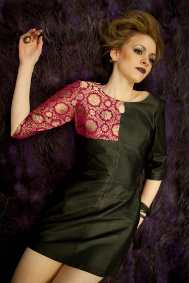
This article has originally been published in the online version of the HandEye magazine, and is republished with permission.
An interview-in-writing
– Interviewee: Shazia Saleem, a London-based ethical and sustainable couture fashion designer, who specialises in hand woven textiles and works in cooperation with Varanasi brocade hand weavers.
– Interviewer: Pamela Ravasio, Twitter: @PamelaRavasio
As a kid, Shazia Saleem marvelled at her mother’s hand woven saris and exquisite brocades, made in many days of painstaking work by some weavers from Varanasi, a city that is still famous for weaving today. An estimated 300’000 weavers live in and around the city. Those that remain earn less than 1$ a day – but more than half the city’s weavers however have either swapped industries, if they were lucky, or are unemployed and living under even worse conditions than before. Linked with their fate is that of their trade and craft – the skills set that led to the creation of some of the most stunning fabrics on our planet, so coveted in the past, could be lost soon.
After her fashion studies in Florence, Shazia went on a research trip to India after having already read extensively about the decline in demand of hand woven textiles. The particular suffering of brocade weavers from Varanasi was highlighted again and again and she was naturally drawn to go and see for herself. She managed to meet weavers and heard their stories first hand, and realised that when buying hand woven textiles, one purchases a piece of history, and makes an investment into the future of the skill by motivating another generation to continue the weaving trade. This was the point of no return: She created her own brand with the firm aim to raise the consciousness of hand woven textiles and bring the term back into popular vocabulary.
Pamela Ravasio: Shazia – finding brocade weavers in Varanasi seems the most straight forward thing imaginable thinking of the city’s reputations. But at the same time, having been to the city myself, I have difficulties imagining where to start looking …

Shazia Saleem: Yes, indeed. Trying to track down some of the weavers the city is renowned for, turns out to be, in fact, rather complicated. My approach was exploration, and I’ll readily admit: it was not easy. Shops selling textiles are everywhere in India but finding weavers is very difficult. They do not reside in main cities and names and addresses are vague. I made enquiries from Delhi and then visited Varanasi to try to find weaver colonies and weavers to work with. I just kept asking people, anyone and everyone, where the weavers were based.
Finally I found some weavers and placed orders with them of my own designs. They thought I was completely crazy and wondered what I was doing there, in their houses, all the way from London (laughs).
But I have worked with these weavers ever since. The challenges were mainly locating the weavers in the first place and then communication becomes the challenge. I speak Hindi so that helped greatly, but technical textile and design vocabulary was not known to me then and I am still learning.
PR: Would you tell us a little about the weavers’ situation as you experience it first hand through your work?
SS: I met quite a few weavers and heard their stories. Each story is different, of course, but similar in that most of the craft people I work with are illiterate and self-employed. Middle men frequently take the most profit and in addition over 90 days’ credit, severely stretching a weaver’s cash flow. Weavers were not encouraging their children to weave due to the poverty conditions many of them live in. Often, weavers could not even afford to purchase the silk with which to weave their designs! The Indian government is trying to step in but not all their revival programmes help and sometimes they simply just add to the disillusionment.

Weaving a brocade usually involves the labour of around 25 people. A weaver often involves the entire family in spinning and setting the loom up but even before this, different people draw the jacquard graph, another person will cut the cards for the loom and so on. Women traditionally have helped only in spinning yarn and other support services but I know of an NGO that is encouraging weavers to consider girls for apprenticeships.
One master weaver I work with is based in a village near Varanasi, close to where Gautam Buddha gave his first sermon. Upon passing away, Buddha was enshrined in the finest Indian handloom muslin or so they say. Hence hand weaving goes back a long time in this part of the world.
In fact, it takes a lot of hard work to take out the middlemen between the buyer – me, in this case – and the weaver/artisan. But by working directly with the weavers, I can obviously negotiate better payment terms [for both partners] directly with them. Over time we build trust through the direct collaboration, which is the important part and basis for all that comes in the future.
PR: What is it specifically about Varanasi brocade that fascinates you?

Genuine handloom textiles from Varanasi are now protected under the Geographical Indication Act which is globally recognised and used by Champagne and Parma (Ham). Enforcing the act will be tough in India but at least it is a step in a serious direction.
PR: You said you design the fabrics your self. Are your designs still guided by traditional patterns? How have you been influenced by the weavers’ knowledge and skills when it comes to deciding the final design?
SS: I design myself and I work with the designs of weavers but I make the colour selections. Sometimes I take two or three designs from weavers and make them into one. I like traditional patterns as much as contemporary designs. I like the challenge of taking an intimidating, traditional and heavy brocade and turning it into a wearable cocktail dress perfectly at home in London or New York.
The other thing to consider with traditional motifs is that they too are becoming extinct so where I can include them, and if they are relevant, I do. Motifs become extinct as consumers tire of old designs and slowly, the motifs become forgotten and weavers forget how they were woven. Of course some classic motifs, such as paisley, can be traditional and contemporary simultaneously.
PR: In your work, you combine the traditional silk brocade with other materials to form contemporary designs – a rather original, if not to say odd, approach from a Western perspective. Design-wise, how do you nevertheless manage to achieve a sense of an elegant whole?


PR: What are the reactions of your customers knowing that the brocade is hand-woven? And that of your weavers when they get to know that their products is part of a high-end fashion garment of a London-based label?
SS: There is a big ‘wow’ factor in knowing that your dress has been hand woven and it feels more special. Brocades from Varanasi are by their very nature not mass produced as weavers are not machines: they get bored weaving the same colours and same designs so bulk ordering is not possible for these reasons and also due to the time scales. For a customer, that means it is unlikely the brocade they are wearing will be re-produced in exactly the same design and this is very special in this age of mass produced generic style.
The weavers feel a great sense of achievement and motivation when they learn the brocades are becoming popular again and it gives them a real sense of income stability knowing that they have orders for the foreseeable future.
Shazia – thank you for your time.

